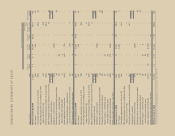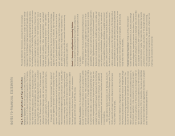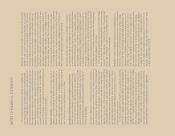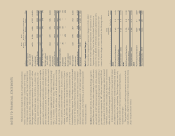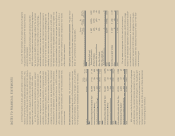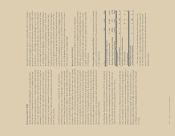Sara Lee 2011 Annual Report Download - page 86
Download and view the complete annual report
Please find page 86 of the 2011 Sara Lee annual report below. You can navigate through the pages in the report by either clicking on the pages listed below, or by using the keyword search tool below to find specific information within the annual report.
NOTES TO FINANCIAL STATEMENTS
Financial Statement Corrections
During 2011, the corporation
corrected an error in the classification of certain asset and liability
balances in the 2010 balance sheet associated with casualty losses
from workers’ compensation, auto liability and general liability claims
by recording a portion of the liability for these losses and the related
insurance receivable as long-term. The correction of this error has
resulted in a $15 million reduction to “other current assets” and a
corresponding increase in “other noncurrent assets” in the 2010
balance sheet. In addition, “other accrued liabilities” was reduced
by $60 million with a corresponding increase in “other liabilities”
(long-term). The correction of this error had a similar impact on the
assets and liabilities of the former North American Fresh Bakery
segment, which are now classified as held for sale on the balance
sheet for all periods presented. The impact of the error on the
assets and liabilities held for sale in the 2010 balance sheet was
$15 million and $79 million, respectively. The corporation has
concluded that this error did not materially misstate previously
issued financial statements.
Note 2 – Summary of Significant Accounting Policies
The Consolidated Financial Statements have been prepared in
accordance with generally accepted accounting principles in the
U.S. (GAAP).
The preparation of the Consolidated Financial Statements in
conformity with GAAP requires management to make use of esti-
mates and assumptions that affect the reported amount of assets
and liabilities, revenues and expenses and certain financial statement
disclosures. Significant estimates in these Consolidated Financial
Statements include allowances for doubtful accounts receivable, net
realizable value of inventories, the cost of sales incentives, useful
lives of property and identifiable intangible assets, the evaluation
of the recoverability of property, identifiable intangible assets and
goodwill, self-insurance reserves, income tax and valuation reserves,
the valuation of assets and liabilities acquired in business combi-
nations, assumptions used in the determination of the funded status
and annual expense of pension and postretirement employee benefit
plans, and the volatility, expected lives and forfeiture rates for stock
compensation instruments granted to employees. Actual results
could differ from these estimates.
Foreign Currency Translation Foreign currency denominated
assets and liabilities are translated into U.S. dollars at exchange
rates existing at the respective balance sheet dates. Translation
adjustments resulting from fluctuations in exchange rates are recorded
as a separate component of other comprehensive income within
common stockholders’ equity. The corporation translates the results
of operations of its foreign subsidiaries at the average exchange
rates during the respective periods. Gains and losses resulting
from foreign currency transactions, the amounts of which are not
material, are included in net income.
Note 1 – Nature of Operations and Basis of Presentation
Nature of Operations Sara Lee Corporation (the corporation or
Sara Lee) is a U.S.-based multinational corporation. The corpora-
tion’s principal product lines are branded packaged meat products,
fresh and frozen bakery products, and roast and ground coffee. The
relative importance of each operation over the past three years,
as measured by sales and operating segment income, is presented
in Note 19, “Business Segment Information,” of these financial
statements. Food and beverage sales are made in both the retail
channel, to supermarkets, warehouse clubs and national chains,
and the foodservice channel.
In January 2011, the corporation announced that its board of
directors has agreed in principle to divide the company into two
separate, publicly traded companies which is expected to be com-
pleted in the first half of calendar 2012. Under the current plan,
the International Beverage business will be spun off, tax-free, into
a new public company (spin-off). The other company will primarily
consist of Sara Lee’s current North American Retail and North
American Foodservice businesses. The separation plan is subject
to final approval by the board of directors, other customary
approvals and the receipt of an IRS tax ruling.
Basis of Presentation The Consolidated Financial Statements
include the accounts of the corporation and all subsidiaries where
we have a controlling financial interest. The consolidated financial
statements include the accounts of variable interest entities (VIEs)
for which the corporation is deemed the primary beneficiary. The
results of companies acquired or disposed of during the year are
included in the consolidated financial statements from the effective
date of acquisition, or up to the date of disposal. All significant
intercompany balances and transactions have been eliminated
in consolidation.
The corporation’s fiscal year ends on the Saturday closest to
June 30. Fiscal years 2011 and 2009 were 52-week years. Fiscal
2010 was a 53-week year. Unless otherwise stated, references
to years relate to fiscal years.
Discontinued Operations
Beginning in 2011, the results of the
North American fresh bakery and North American refrigerated dough
businesses are being reported as discontinued operations. The
results of the household and body care operations and the corpo-
ration’s Mexican meats business had previously been reported as
discontinued operations in the corporation’s 2010 annual report.
The results of operations of these businesses through the date of
sale are presented as discontinued operations in the Consolidated
Statements of Income. Prior to disposition, the assets and liabilities
of discontinued operations are aggregated and reported on separate
lines of the Consolidated Balance Sheets.










